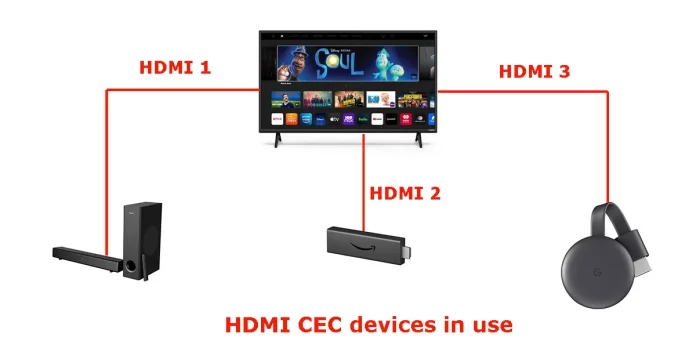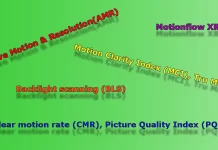HDMI-CEC (High-Definition Multimedia Interface – Consumer Electronics Control) is a protocol designed to optimize the performance of multiple devices connected via HDMI. It is primarily used to control various components connected to the TV, such as soundbars and video players. HDMI-CEC provides centralized control from a single device.
While convenient, HDMI-CEC is a relatively simplistic and outdated technology that supports only a limited set of commands. Many of these commands are obsolete or no longer in use. Some of the most commonly used functions include turning on devices, pause, audio control, and video rewind.
History of HDMI CEC
Consumer Electronics Control (CEC) originated in the 1980s, a period when VCRs and audio systems were becoming widespread. At that time, connecting a VCR to a TV and incorporating a speaker system for enhanced audio was common. The invention of the SCART connector revolutionized this setup by consolidating multiple ports—previously required for TVs, VCRs, and audio equipment—into a single, multifunctional interface. This innovation also introduced a control protocol that allowed devices to communicate commands to one another seamlessly.
With the transition to HDMI ports, CEC was integrated into this new digital standard, shifting device control from analog to digital connections. However, because CEC support was not mandatory, its implementation varied across different manufacturers of electronic devices.
HDMI CEC usage example and command
HDMI CEC (Consumer Electronics Control) enables you to control multiple devices using a single remote. Essentially, one device can broadcast commands to other connected devices. For instance, imagine you have a TV, a streaming device like Roku or Chromecast connected to the TV’s HDMI port, and a sound receiver or soundbar connected to another port labeled HDMI ARC (eARC). By enabling HDMI CEC on all these devices, they can operate as a unified system. Turning on one device will automatically turn on all the connected devices. For example, you can ask Alexa to turn on the TV, and the soundbar and Chromecast will also power up. You can then control the streaming device and soundbar volume using the TV remote.
Requirements for HDMI CEC
To use HDMI CEC, certain conditions must be met:
- Compatible HDMI Cable: The HDMI cable must support CEC and include a dedicated wire to carry the CEC signal. Some cables might not have this wire to reduce costs.
- CEC-Enabled Devices: All devices you want to control must support HDMI CEC.
Supported Commands
Although CEC specifications support a wide range of commands, manufacturers often implement only a few of them, leading to compatibility issues. Here are the main commands supported by CEC:
- One Touch Play: Allows devices to switch the TV to the active source when playback starts. For example, starting playback on a Fire Stick will automatically switch the TV to the correct HDMI input.
- System Standby: Controls power to devices. Turning on the TV will automatically turn on the soundbar and streaming device.
- Preset Transfer: Transfers tuner channel settings to another TV. This command is obsolete and rarely used.
- One Touch Record: Allows users to record the content currently displayed on the TV screen onto a recording device. This command is obsolete as modern TVs generally do not have recording capabilities due to copyright protection.
- Timer Programming: Originally implemented for time-based recording of TV programs, this command can automatically turn on devices.
- System Information: Checks all components for bus addresses and configuration, scanning for connected devices.
- Deck Control: Allows a component to control playback operations (play, pause, rewind) of another device, such as a Blu-ray player.
- Tuner Control: Enables a component to control the tuner of another device. For example, using the TV remote to change channels on a cable set-top box.
- OSD Display: Displays the menu of a connected device on the TV screen.
- Remote Control Pass Through: Sends remote control commands to other devices in the system.
- OSD Device Name Pass Through: Transmits the name of the connected device to the TV.
- Audio Control: Allows volume control of the AV receiver, integrated amplifier, or preamplifier using any remote control from an appropriately equipped device in the system.
The implementation of supported commands varies by manufacturer. As a result, devices from different brands often support only a limited number of commands, typically basic switching and sound control.
The Marketing Evolution of HDMI CEC: Brand-Specific Naming
When HDMI CEC was introduced in 2007, it coincided with a period when TVs lacked significant technological innovations. To capitalize on this new feature, marketing departments across various companies branded HDMI CEC support with unique names, making it appear as if their TVs had exclusive capabilities.
For instance, Samsung marketed their TVs with the name Anynet+, leading consumers to believe they were getting something special. This strategy resulted in numerous brand-specific names for HDMI CEC. Here are some examples:
- Samsung: Anynet+
- Sony: BRAVIA Sync
- LG: SimpLink
- Panasonic: VIERA Link
- Toshiba: Regza Link
- Sharp: Aquos Link
- Philips: EasyLink
- Pioneer: Kuro Link
- Hitachi: HDMI-CEC
- Mitsubishi: NetCommand for HDMI
- Onkyo: RIHD (Remote Interactive over HDMI)
Each brand’s unique name contributed to the perception that their HDMI CEC implementation was distinctive, even though they all provided similar functionality.






